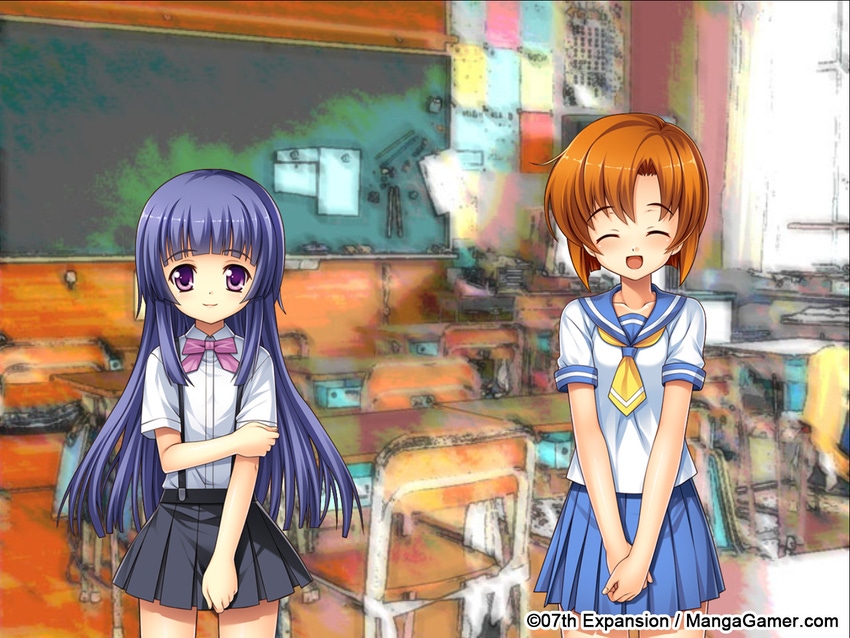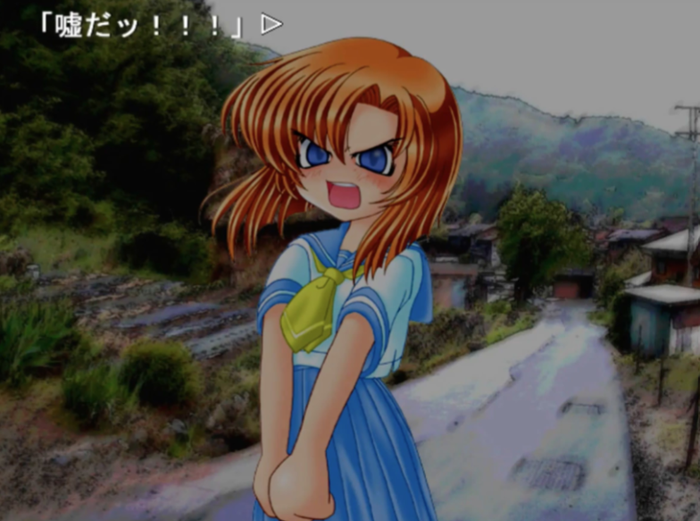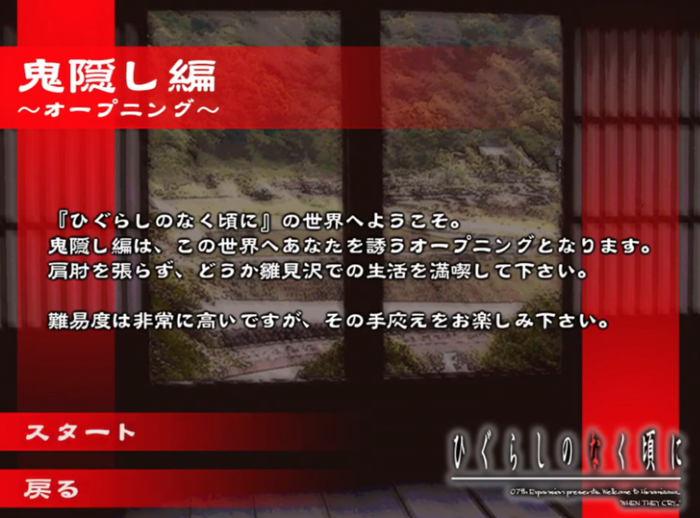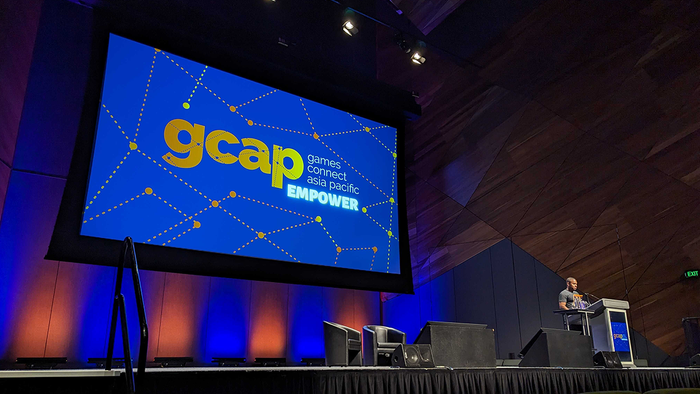
Featured Blog | This community-written post highlights the best of what the game industry has to offer. Read more like it on the Game Developer Blogs.
Can Ryukishi07’s “Sound Novels” be considered Games?
This short blog post will examine Higurashi’s design and apply concepts used in both Western and Japanese game theory to see if this sound novel series can be categorized as a “game.”
February 14, 2024

WARNING: This post does include minor spoilers for the franchise’s story. Readers BE AWARE!
Japanese game designer, Ryukishi07 (竜騎士07), started selling his stories in the doujinsoft (同人ソフト) market when he was 28 years old, inspired by TYPE-MOON’s Tsukihime (月姫.) Although in the West we call the genre “Visual Novel,” Ryukishi07 prefers calling his games “Sound Novels” despite the term being a “registered trademark in Japan.”[1] With the help of his family to produce the copies of the game, the writer debuted his first murder mystery Sound Novel, Onikakushi-Hen (鬼隠し編: “Demoned Away Chapter”), at ComiKet 62 in 2002.[2] This was the first of the goliath visual novel franchise, Higurashi no Naku Koro ni (ひぐらしのなく頃に: “When the Cicadas Cry”) that has led to seven more “main series” novels and several side stories, spin-offs, anime and manga adaptations, and live action movies. Although the story is linear and non-branching, many consider the eight main series novels to be games based on the “theory crafting” that Ryukishi07’s writing encourages players to do before finding the culprit of the incidents occurring in the village in the later games. This short blog post will examine Higurashi’s design and apply concepts used in both Western and Japanese game theory to see if this sound novel series can be categorized as a “game.”
The story of Higurashi itself is divided into eight main installments, four Question chapters and four answer chapters, with the first half of the series having all of the “clues” to solve the mystery of the culprit behind the tragedies that occur in the June of 1983 within the village, Hinamizawa (雛見沢). Although the content in the last four games vary in events, they still coincide with the information you receive through the first four stories to answer the mysteries that were presented in the first few chapters. An example of these questions being, why do the characters that die in the first game return for the next few games alive and without memories of their deaths? It is explained in the seventh game, Minagoroshi-hen (皆殺し編: “Massacre Chapter,”) that the village’s miko (巫女) was stuck in a time loop that would only resolve when she and her friends band together to face the culprit who was responsible for killing the whole village in other worlds called “kakera” (カケラ). At the end of each chapter, there is an unlockable segment that players can only read when they complete the chapter where the characters meet at a Maid Café to discuss the events that occur and ponder among themselves on different answers to the mystery. These segments are designed to get the reader to think about the mysterious elements of the game and provide them with clues to base their own conclusions off of, and many readers consider this to be Ryukishi07’s way of introducing the “gameplay element” of the Higurashi series.

“The fan favorite “(You Liar!)” jumpscare from Onikakushi-hen.
Before I go into if the series follows game design principles, I will briefly look into the concept of what “games” are in America and Japan. The most basic definition of the concept would come from Merriam Webster’s dictionary definition of the term: “a physical or mental competition conducted according to rules with the participants in direct opposition to each other.”[3] Another view for the definition of games would apply to Dutch Historian Johan Huizinga’s classifications of “play” in his 1950 book Homo Ludens which states that it is a “free activity” that is “outside ‘ordinary life’” that absorbs the player.[4] For an approach of the concept in Japan, the historical piece of Japanese mythology, the Kojiki (古事記), has a tale that has formed the modern word of “play,” asobi (遊). When Amaterasu Ōmikami (天照大神) hid in a rock cave after the cruel pranks of her brother, Susanoo-no-Mikoto (須佐之男命), Ame-no-Uzume (天宇受売命) danced in front of the Gods to make them laugh to entice Amaterasu to peer out of the cave for the others to force her out to get the sun to shine upon the lands once more. Her half-naked dance was referred to as “asobi” in the Kojiki, which was the first form of the term to be used in the Japanese language. However, the term “asobi” is used for many kinds of play with it applying to more than just games. Broadly speaking, there is no one definition of “Games” in Japanese culture like how we can condense the term in English.
The term ゲーム spelled in Katakana is a borrowed word from the West that is mainly used to define forms of media, like Video or Board Games, that never had a native word to begin with. Although Japan had games, they were not all defined under the same umbrella term that Westerners use for the concept. “Asobi” can be applied to games, but games are not the only form of play within the definition of the term. In terms of philosophy of what videogames are in Japan, Mario creator Shigeru Miyamoto (宮本, 茂) says that games “need a sense of accomplishment[5],” while Yakuza creator Toshihiro Nagoshi (名越, 稔洋) believes that games need to be “surprising” with players knowing what to expect from a game to be a failure in its general design[6]. In the West, game designers like Sid Meier states that games are like “a series of interesting decisions[7]” while Jane McGonigal has gone on to say that games could potentially be made to “solve problems” in our world[8].
So, where does Ryukishi07’s Higurashi series lie in these definitions? To start, the creator’s definition of Visual Novels lies in the concept that they are different from novels, manga, and anime. There is not “any music” or art in novels, manga does not have as much “prose” in its writing, and anime has the similar “disadvantage in prose” as manga alongside having a larger budget[9]. Higurashi falls within the Visual Novel genre to which Ryukishi07 himself has never been on record disclaiming them as games in any interviews. When you open the first game, Onikakushi, an ominous statement in its beginning blurb reads towards its end, “The difficulty for this chapter is extremely high” (難易度は非常に高いですが),[10] which indicates the challenge that the series gives to its readers to solve the mystery before the series’ answer arcs reveal the truth with the statement afterwards implying that the player will feel rewarded for their efforts if they get a close answer. There are also optional “TIPS” segments at the end of each story section to give more context regarding the events of the chapter to further give hints towards the answers of the mysteries to the readers. Meaning that there is a potential chance of the novel pointing people to the correct direction to base their theories from, but allowing them to choose if they want the extra help.

Going to the definitions of “games” and “play” listed earlier, Higurashi can be applied to the terms stated by Huizinga, Miyamoto, Nagoshi, Meier, and even McGonigal. It does not align to Webster’s definition however as there is no opposing side that “players” are going against, unless the mystery can be considered a participant. Outside of that definition, the eight games do allow players to immerse themselves in a separate world with an activity to solve the mystery of the cause of the strange events in the village, fulfilling Huizinga’s definition of play. If players are successful in their “theory-crafting” to a storyline that matches or is similar to the Answer Chapter’s solution they will feel the accomplishment of figuring out the answer of the mystery before it is told to them in the last four installments, fulfilling Miyamoto’s definition. Regardless of their theories, the events in the story, from a school hostage situation in Tsumihoroboshi-hen (罪滅し編: Atonement Chapter) to witnessing the tragedy of the Sonozaki (園崎) twins separation and abuse by their family in Meakashi-hen (目明し編: Eye Opening Chapter), are suspenseful even during the conclusion parts of the series, fulfilling Nagoshi’s definition. The process of forming different answers to the mysteries proposed in the Question games allows the readers to choose their interpretations, fulfilling Meier’s definition loosely. Lastly, the philosophical questions of the morality of murder, the joys of friendship, and the sense of village community can bring insights to our own world’s debates and answers to serious issues, fulfilling McGonigal’s mission and definition.
In conclusion, with the fulfillment of these definitions I had listed in this paper, I believe that Ryukishi07’s Higurashi “Sound Novels” is a form of a mental mind game. It challenges you to think about a mysterious narrative and to draw your own conclusions to what is occurring in the story, before the game rewards you with its true answer that may validate or invalidate your process of “Theory-Crafting.”
[1] Bandrac, Damien “Amo.” “Interview Avec Ryukishi07, Auteur Chapeauté.” Journal Du Japon (Wayback Machine Archive), Journal du Japon, 10 June 2012, web.archive.org/web/20140330025805/www.journaldujapon.com/2012/06/interview-ryukishi07-le-sanglot-des-otaques.html.
[2] Shiba. “原作の鬼隠し編をやってみた (I Tried the Original Onikakushi-Hen).” ひぐうみブログ, ひ��ぐうみブログ (Higu/Umi Blog), 1 Apr. 2010, higuumi07.blog.fc2.com/blog-entry-854.html.
[3] “Game Definition & Meaning.” Merriam-Webster, Merriam-Webster, 24 Jan. 2024, www.merriam-webster.com/dictionary/game.
The Electronically Published date follows the most updated version of the definition at the time of publishing.
[4] Huizinga, Johan. Homo Ludens: A Study of the Play-Element in Culture. Roy Publishers, 1950.
[5]Haubursin, Christophe, and Joe Posner. How the Inventor of Mario Designs a Game. YouTube, Vox, 12 Jan. 2017, https://www.youtube.com/watch?v=K-NBcP0YUQI. Accessed 31 Jan. 2024.
[6] Archipel. Toshihiro Nagoshi, Making Yakuza. Archipel, YouTube, 19 Nov. 2020, https://www.youtube.com/watch?v=MTI7BUZ4rgc. Accessed 31 Jan. 2024.
[7] Alexander, Leigh. “GDC 2012: Sid Meier on How to See Games as Sets of Interesting Decisions.” Game Developer, 10 Oct. 2023, www.gamedeveloper.com/design/gdc-2012-sid-meier-on-how-to-see-games-as-sets-of-interesting-decisions.
[8] “Gaming Can Make a Better World.” Ted, TED Conferences, LLC., https://www.ted.com/talks/jane_mcgonigal_gaming_can_make_a_better_world?language=en.
[9] Thompson, Jason. “Alone in the Dark: An Interview With the Creators of Higurashi When They Cry.” Yen Plus, vol. 1, no. 5, Dec. 2008.
[10] Trans. “The difficulty for this chapter is extremely high.” Each Chapter of the Question arcs begins with one of these statements regarding the difficulty of the entry’s mystery.
Read more about:
Featured BlogsAbout the Author(s)
You May Also Like







